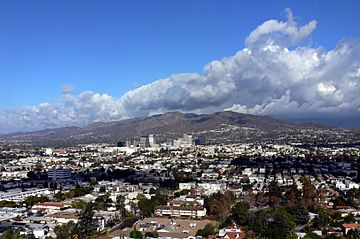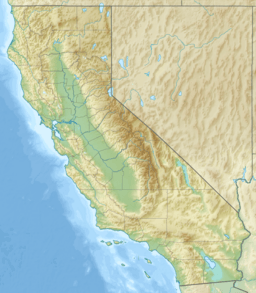Verdugo Mountains facts for kids
Quick facts for kids Verdugo Mountains |
|
|---|---|
| Verdugos | |

Verdugo Mountains, south view
|
|
| Highest point | |
| Peak | Verdugo Peak |
| Elevation | 3,126 ft (953 m) |
| Geography | |
| Country | United States |
| State | California |
| District | Los Angeles County |
| Range coordinates | 34°13′N 118°17′W / 34.217°N 118.283°W |
| Parent range | Transverse Ranges |
| Topo map | USGS Burbank |
The Verdugo Mountains are a small, rugged mountain range in Southern California. They are part of the Transverse Ranges system and are located in Los Angeles County. People sometimes call them the Verdugo Hills or just the Verdugos.
These mountains are completely surrounded by cities and towns. This makes them like a special island for wildlife. A lot of the land is public parkland that hasn't been built on. People mostly use the Verdugo Mountains for fun activities like hiking and mountain bike riding. They also have communication towers on their highest peaks.
The mountains rise sharply from the eastern San Fernando Valley. This makes them look even taller than they are. They start with small hills and quickly become rugged, with some peaks reaching over 3,000 feet high.
Contents
Exploring the Verdugo Mountains
The Verdugo Mountains stretch about 8 miles (13 km) long and 3.25 miles (5.2 km) wide. They run almost parallel to the San Gabriel Mountains, with the Crescenta Valley in between. The southern side of the Verdugos forms part of the edge of the San Fernando Valley. On their southeastern end, the Verdugo Wash separates them from the San Rafael Hills.
Highest Peaks and Landmarks
The highest point is called Verdugo Peak, which is 3,126 feet tall. It's located near the middle of the mountain range. Another important peak is Tongva Peak, which is 2,656 feet high. This peak was recently named to honor the Tongva people. They were the first people to live in much of the Los Angeles Basin area. Other peaks include Mount La Tuna on the north side and Mount Thom on the south side. Most of these peaks have communication towers on them.
The Verdugo Mountains are located within the cities of Glendale, Burbank, and Los Angeles. Nearby neighborhoods include La Crescenta, Tujunga, Shadow Hills, and Sun Valley.
How the Mountains Were Formed
The Verdugo Mountains were formed by movements in the Earth's crust. They are like a large block of land that has been pushed up. This happened because of huge cracks in the Earth, called faults. The Verdugo Fault is on the south side, and the Sierra Madre Fault is on the north side.
The rocks in the Verdugo Mountains are mostly igneous and metamorphic rocks. These are similar to the old, hard rocks found in parts of the San Gabriel Mountains. However, some areas, like the Shadow Hills neighborhood, have younger sedimentary rocks like sandstone and shale.
The Verdugo Mountains are part of the western Transverse Ranges. These mountains have been rising over the last 7 million years. This uplift is caused by the slow but powerful movement of the Earth's plates, especially near the "Big Bend" area of the San Andreas Fault. The Verdugo Mountains are still rising quickly today. This is why they have steep slopes and why erosion happens fast here.
Plants, Animals, and Weather
The Verdugo Mountains are mostly covered by a plant community called chaparral. This is a dense, shrubby type of forest common in California. The chaparral grows thicker on the cooler, north-facing slopes.
Common Plants
Some common shrubs you'll find here include laurel sumac (Malosma laurina), toyon (Heteromeles arbutifolia), poison oak (Toxicodendron diversilobum), and chamise (Adenostoma fasciculatum). There are also two types of California-lilac (Ceanothus crassifolius and Ceanothus oliganthus).
Native trees usually grow in protected canyons where there is more moisture. These include coast live oak (Quercus agrifolia), California bay laurel (Umbellularia californica), California sycamore (Platanus racemosa), California walnut (Juglans californica), and several types of willow (Salix spp.). Some non-native trees like pines, cypress, and eucalyptus have also been planted along the fire roads.
Wildlife in the Mountains
Because the Verdugo Mountains are surrounded by cities, they are like an island for wildlife. They have a small connection to the larger wild areas in the San Gabriel Mountains through Big Tujunga Wash.
Common large animals include coyotes (Canis latrans) and mule deer (Odocoileus hemionus). Sometimes, mountain lions (Puma concolor) and black bears (Ursus americanus) are seen. Many types of rodents live here, which support a population of western rattlesnakes (Crotalus viridis).
One special bird found here is the wrentit (Chamaea fasciata). It's small and hard to see, but you can often hear its unique call. It sounds like three or four chirps followed by a fast trill, like a ping-pong ball bouncing faster and faster.
Climate and Weather
The Verdugo Mountains have warm, dry summers and cool, wet winters. Snow sometimes falls on the highest parts during winter storms, but it melts quickly. The amount of rain changes a lot each year. More rain usually falls during El Niño years. Most of the rain comes between November and March.
History of the Verdugo Mountains
The Tongva people lived in these mountains for over 7,000 years. They had villages near the springs in the canyons.
The mountains are named after Jose Maria Verdugo. He was given a large piece of land called Rancho San Rafael by the Spanish government in 1784. This rancho covered the mountains. Its boundaries were mostly defined by the Verdugo Mountains, the Arroyo Seco, and the Los Angeles River.
Early Railway Plans
In 1912, there was a plan to build a special cable railroad up Mount Verdugo (now Mount Thom). This project was called the Glendale & Verdugo Mountain Railway. It would have carried people from the Pacific Electric Railway station in Casa Verdugo straight to the top of the mountain. The idea was to have several stations along the way and a big visitor center at the summit. However, the project was never built. This was mainly because the Pacific Electric company decided not to extend its railway line to Montrose, which was key to the plan.
Wildfires in the Mountains
Fire is a natural part of the chaparral ecosystem. The plants here are adapted to survive fires or grow back afterward. However, fires need to happen at the right frequency. In Southern California chaparral, natural fires usually occur every 30 to 40 years. If fires happen too often, the shrubs can be replaced by grasses, especially non-native ones.
The Verdugo Mountains have had many wildfires throughout history.
- In December 1927, the Burbank Canyon Fire burned homes in Burbank.
- The La Tuna Canyon Fire in November 1955 burned almost the entire western part of the range.
- The Whiting Woods Fire in March 1964 burned homes in Glendale.
- Another La Tuna Canyon Fire in November 1980 burned a large area in the northern and western parts of the mountains.
More recently, there have been several major fires:
- In September 2002, the Mountain Fire burned about 750 acres above Glendale.
- The Harvard Fire started in September 2005 and burned over 1,000 acres.
- In September 2017, the La Tuna Fire started north of the Verdugos. It jumped Interstate 210 and burned both sides of the mountains, destroying four homes and over 7,000 acres of land.
To help control fires, the Los Angeles County Fire Department began building fuel breaks (areas cleared of plants) in the Verdugos starting in the 1920s. In 1934, the City of Glendale built a lookout tower on Verdugo Peak to spot fires.
Protected Areas
Many parts of the Verdugo Mountains are protected lands. These areas help preserve the natural environment and provide places for recreation.
- Verdugo Mountains State Park, managed by the California Department of Parks and Recreation
- Verdugo Mountains Open Space Preserve, managed by the Santa Monica Mountains Conservancy and the City of Glendale
- Brand Park, Glendale
- Stough Canyon Nature Center, Burbank
- Wildwood Canyon Park, Burbank
- La Tuna Canyon Park, Los Angeles
- Tujunga Ponds, Los Angeles
The Verdugo Mountains are also being considered as part of a larger proposed National Park called the Rim of the Valley Corridor.
Getting Around and Having Fun
There are no paved roads that cross the Verdugo Mountains, except for the Foothill Freeway (I-210) and La Tuna Canyon Road, which only go through the very northwestern tip.
However, the mountains have more than 25 miles (40 km) of well-kept fire roads. These roads are great for hiking and mountain bike riding. There are also a few engineered footpaths, like the 2.2-mile (3.5 km) La Tuna Canyon Trail, which was built in 1989.
Maps
- Angeles Front Country Trail Map. San Rafael, California: Tom Harrison Maps, 2001. ISBN: 1-877689-65-3.
- Verdugo Mountains trail map. Matt Maxon, 2005 http://pctmap.homeip.net/data/PDF/Verdugo%20Mtns%2001-16-05.pdf
- Burbank, California, 7.5 minute topographic quadrangle map. United States Geological Survey.
- Pasadena, California, 7.5 minute topographic quadrangle map. United States Geological Survey.
- Mount La Tuna - 34°13′24″N 118°20′15″W / 34.22327°N 118.33763°W
- Verdugo Peak - 34°12′55″N 118°16′48″W / 34.21518°N 118.28001°W
- Tongva Peak - 34°11′50″N 118°15′30″W / 34.19722°N 118.25833°W
- Mount Thom - 34°11′14″N 118°15′21″W / 34.18717°N 118.25596°W


